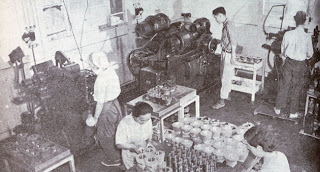
After World War II, Soichiro Honda formed the Honda Research Institute Company in Japan. In 1947, Honda built the A-type engine, a 1-horsepower 50cc two-stroke that fastened to bicycles. Honda staff called it the “chimney” because of its tall cylinder. In September 1948, the Honda Motor Co. was formally established.
.jpg)
The first production automobile from Honda was the T360 mini pick-up truck which was powered by a small 356 cc straight-4 gasoline engine. The first production car from Honda was the S500 sports car. In 1961, the bigger Volvo model engines called the 122-S series B-18 engine were built. In 1965, Honda built a race car equipped with a 12-cylinder engine.

In 1973, The Ford Motor Company formed an agreement with The Honda Motor Company to obtain technical data on a new engine that would decrease air pollution. They created the first engine to meet the guidelines of the 1970 US Clean Air Act.
.jpg)
In 1991, Honda reported selling 7000 CRX-HF cars where the Honda engine used computers and sensors to control valve action and the air-fuel. The purpose was to increase the amount of air in the mixture to 20 parts per 1 part gasoline.

In May 1999, Honda announced that it would supply its new Formula 1 engines to British American Racing. The most important highlight of the announcement was that Honda’s engine engineers had developed an oil trap that fitted into the engine. Also in 1999, Hybrid Electric Honda launched the first commercial hybrid electric car that was sold in the US as the Honda Insight. The first-generation Insight was produced from 2000 to 2006. This was the most fuel-efficient mass-produced car at the time. In 2000, Honda began mass producing clean high-performance engines.
The Honda Civic GX is the only natural gas vehicle (NGV) available in certain US locations. In 2001, the Civic GX was rated the cleanest-burning internal combustion engine in the world by the U.S. Environmental Protection Agency.

In late 2006, Honda’s Brazilian subsidiary launched flexible-fuel versions for the Honda Civic and Honda Fit. These models run on a mixture of hydrous ethanol (E100) and E20-E25 gasoline.
Honda introduced the second-generation Insight in Japan in February 2009. It will be the cheapest hybrid available in the US.
Since 2002, Honda has been selling the Honda Civic Hybrid (2003 model) in the US. It was followed by the Honda Accord Hybrid, which was offered in 2005 to 2007 models. Honda is also planning to introduce a hybrid version of its Honda Fit, as well as another unique small hybrid vehicle based on the CR-Z sports car that was introduced at the 2007 Tokyo Motor Show.

Honda has a remarkable history of building solid engines. It will be interesting to see what the future of the Honda engine will bring.
Honda Mall of Georgia is so proud to represent a manufacturer who is always thinking ahead - customer, experience, environment and ingenuity. If you have not come by to test drive a hybrid, come by and get a taste of the latest passion.

No comments:
Post a Comment